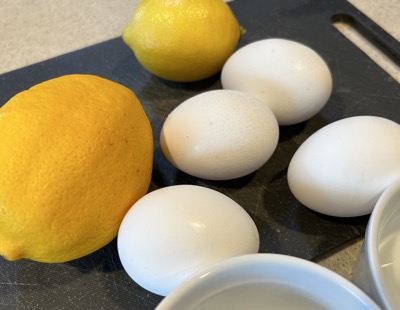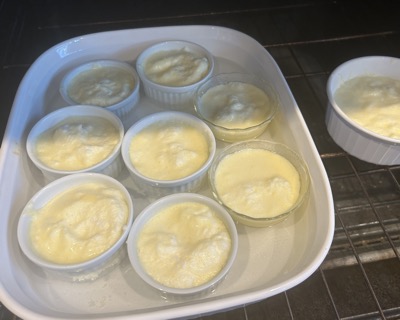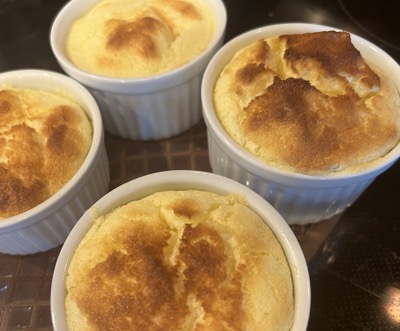
Recipe: Bake them in ramekins for easy serving now or later

Baked in ramekins, lemon pudding cakes are easy to serve for a fancy dessert or a special brunch dish. Kathy Morrison
The lemons have been piling up, and I needed to bake something. But not something heavy, or which created too many leftovers.

I happened on a recipe for lemon pudding cake among the thousands of NY Times recipes. Rule with those is: Always read the comments. And in this case, the commenters' consensus was 1) Increase the amount of lemon and 2) Bake the cake in individual ramekins for easier serving plus easier storing of any leftovers.
The second part was easy to follow: I prepped six ramekins and two custard cups, because that would fit in the roasting pan where they would bake. As it happened, I had extra batter, so pulled out a slightly larger ramekin (see photo) and poured the rest of the batter in that to bake outside the roasting pan.
Why a roasting pan? This cake works its magic -- creating a pudding layer under a light cake layer -- while baking in a "bain-marie," a water bath that gently heats the contents.
Since this recipe uses several eggs, and not much flour, it results in something like a souffle, but not quite so delicate. It will puff up, then deflate a bit, but with the custardy layer underneath.
The original recipe uses an 8-inch baking dish, which is fine, but the contents have to be scooped out, and there's the risk of the contents weeping when leftovers (if any) are refrigerated.
The only fussy part of this recipe, really, is the separating of the eggs so the whites can be whipped. I don't usually like whipping eggs, but this time it went very fast.

And here's the secret: Separate the eggs when they're still-refrigerator cold, but let the whites warm up a bit -- 20 minutes -- before whipping them.
And use as much lemon zest as you like. I combined tart and Meyer lemon zest, but using either will work fine.
Lemon pudding cakes
Serves 8 to 10, in ramekins or in one baking dish
Ingredients:
4 large eggs
Butter for baking dish or ramekins, plus 1 tablespoon butter, melted
2 medium to large lemons, either tart or Meyer variety, or both
1/2 cup all-purpose flour
3/4 cup granulated sugar
1/2 teaspoon kosher salt
1-1/2 cups whole milk or half-and-half
Sweetened whipped cream and raspberries for garnish, optional
Instructions:

Remove the eggs from the refrigerator and as soon as possible crack and separate them, putting the whites in a large bowl (glass or metal preferred) and the yolks in another large bowl. Set aside.
Butter the ramekins or baking dish. Preheat the oven to 350 degrees F and set in the oven, on a middle rack, whatever roasting pan(s) you plan to use as the bain-marie. Set about 1 quart of water to boil on the stove, in an electric tea kettle, or in the microwave. (A large glass measuring cup works well in the latter, since you'll have to pour the water.)
Zest enough lemon to get 1 teaspoon zest, minimum, or more to taste. (I used not quite 1 tablespoon). Juice the lemons to get 1/3 cup juice.
Combine the lemon zest, juice and 1 tablespoon melted butter with the egg yolks. In a small bowl, whisk together the flour, sugar and salt.
Stir half the flour mixture into the egg yolk mixture, then half the milk. Repeat with the flour, and then the rest of the milk.
Now the egg whites: Whip until soft peaks form, then gently fold them into the batter. It's OK and in fact preferable if the whites are not completely incorporated into the batter.
Divide the batter between the prepared ramekins, or pour into the prepared baking dish.
Open the oven and partly pull out the rack holding the roasting pan. Set the filled ramekins or baking dish in the pan and CAREFULLY pour the hot water around the ramekins or dish. The water should come about halfway up the side.
Carefully push the rack back into the oven. Bake the pudding cakes for 25-30 minutes, or the single dish for about 45 minutes.
The roasting pan is hot and quite heavy when filled so you want to avoid moving it much. When the cakes are set, puffy and lightly brown, remove them from the hot water to a cooling rack using kitchen tongs or two hot pads. Turn off the oven. Leave the pan of water in the cooling oven until you can move it safely.
Serve the cakes immediately, with whipped cream and berries for garnish, or cool them, cover with plastic wrap and refrigerate for later.
Comments
0 comments have been posted.Sacramento Digs Gardening to your inbox.
Sites We Like
Garden Checklist for week of May 12
Get your gardening chores and irrigation done early in the day before temperatures rise.
* Plant, plant, plant! It’s prime planting season in the Sacramento area. Time to set out those tomato transplants along with peppers and eggplants. Pinch off any flowers on new transplants to make them concentrate on establishing roots instead of setting premature fruit.
* Direct-seed melons, cucumbers, summer squash, corn, radishes, pumpkins and annual herbs such as basil.
* Harvest cabbage, lettuce, peas and green onions. This heat will cause leafy greens and onions to flower; pick them before they bolt.
* In the flower garden, direct-seed sunflowers, cosmos, salvia, zinnias, marigolds, celosia and asters.
* Plant dahlia tubers. Other perennials to set out include verbena, coreopsis, coneflower and astilbe.
* Transplant petunias, marigolds and perennial flowers such as astilbe, columbine, coneflowers, coreopsis, dahlias, rudbeckia and verbena.
* Keep an eye out for slugs, snails, earwigs and aphids that want to dine on tender new growth.
* Feed summer bloomers with a balanced fertilizer.
* For continued bloom, cut off spent flowers on roses as well as other flowering plants.
* Got fruit trees? If you haven't already done so, thin orchard fruit such as apples, peaches, pears, pluots and plums before they grow too heavy, breaking branches or even splitting the tree. Leave the largest fruit on the branch, culling the smaller ones, and allow for 5 to 6 inches (or a hand's worth) between each fruit.
* Thin grape bunches, again leaving about 6 inches between them. For the remaining bunches, prune off the "tail" end, about the bottom third of the bunch, so that the plant's energy is concentrated in the fruit closest to the branch.
* As spring-flowering shrubs finish blooming, give them a little pruning to shape them, removing old and dead wood. Lightly trim azaleas, fuchsias and marguerites for bushier plants.
* Add mulch to the garden to help keep that precious water from evaporating. Mulch also cuts down on weeds. But don’t let it mound around the stems or trunks of trees or shrubs. Leave about a 6-inch to 1-foot circle to avoid crown rot or other problems.